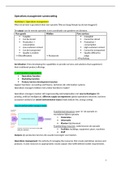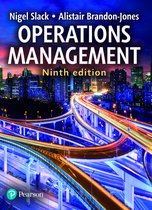Operations management samenvatting
Hoofdstuk 1 Operations management
Alles om je heen is gecreëerd door een operatie (Wat je draagt/koopt/op zit/eet/weggooit)
De output van de meeste operaties is een combinatie van goederen en diensten.
Pure goods Midden Pure services
Tangible Intangible
Can be stored Cannot be stored
Production -> Production =
consumption consumption
Low customer contact High customer contact
Can be transported Cannot be transported
Quality is evident Quality difficult to
→ Olieraffinaderij → Restaurant judge
→Psycholoog
Servitization: firms developing the capabilities to provide services and solutions that supplement
their traditional product offerings.
3 core functions organizations
Operations function
Marketing function
Product/service development function
Support functions: accounting and finance, technical, HR, information systems.
Operations managers hebben met al deze functies te maken!
Operations managers moeten zich tegenwoordig ook bezighouden met new technologies (3D
printing, artificial intelligence), different supply arrangements (global operations networks, business
ecosystem analysis) en social/environmental issues (triple bottom line, energy saving).
Input-transformation-output model
Transformed resources: gaan ‘in’ de operatie en
veranderen tijdens operatie
Materialen
Informatie
Klanten (bij diensten)
Transforming resources: ondersteunen de operatie
Facilities: buildings, equipment, plant, machines
Staff
Outputs zijn producten/services die waarde toevoegen voor klanten.
Operations management: the activity of managing the resources that create and deliver services and
products. It uses resources to appropriately create outputs that fulfill defined market requirements.
1
,Operaties kan je op drie niveaus analyseren (Process hierarchy):
Level of the supply network: alle operaties zijn deel van een groter
netwerk.
→ concernniveau supermarkt
Level of the operation: alle operaties bestaan uit verschillende
processen
→ individuele supermarkt
Level of the (individual) process
→ groenteafdeling, vleeswaren, kassa’s (proces binnen een operatie)
4V model van een operatie:
Hoeveel is er van het product/de dienst?
Is het aanbod gevarieerd?
Fluctuaties in de vraag
De mate van zichtbaarheid: hoeveel ervaar je van de operatie
als klant?
!Laag volume/hoge variëteit gaan vaak gepaard!
De laagste kosten per product als: hoog volume, lage variety/variation/visibility
Volume
Laag volume: vaak exclusiever/duurder. Weinig herhaling, weinig systematie en hoge kosten per
product → trouwjurken
Hoog volume: veel herhaling, specializatie, kapitaalintensief, lage kosten per product →
spijkerbroeken
Variety
Hoge variety: flexibel, complex, match customer needs, hoge kosten per product → taxi
Lage variety: routine, gestandaardiseerd, voorspelbaar, lage kosten per product → bus
Variation in demand
Hoge variation: veranderende capaciteit, flexibel, anticipatie, hoge kosten per product,
seizoensgebonden → Center parks
Lage variation: stabiel, routine, verwacht, lage kosten per product → IBIS hotel
Visibility
Hoge visibility: korte wachttolerantie, satisfaction > customer perception, customer contact skills,
hoge kosten per product → kapper (service)
Lage visibility: time lag production-consumption, standaardisatie, weinig contact, centralisatie, lage
kosten per product → stomerij
2
, Key questions
1. What is operations management? Operations management uses resources to appropriately create
outputs that fulfill defined market requirements.
Gericht op creation + delivery goederen en diensten.
Operations management houdt zich bezig met het managen van processen.
2. Why is operations management important in all types of organizations? Ieder bedrijf dat iets creëert
gebruikt ‘resources’ om output te creëren. Operations managament managet dit proces.
3. What is the input-transformation-output process? Bij iedere operatie worden transformed resources
(material-info-customers) getransformeerd, ondersteund door transforming resources (facilities, staff)
om een output (producten/diensten) te leveren die waarde toevoegt voor de klant.
4. What is the process hierarchy? Supply network – operation – process
5. How do operations and processes differ? 4V’s: volume/variety/variaton/visibility
6. What do operations managers do? Direct strategy – design – plan and control process delivery –
develop process performance (improvement)
Hoofdstuk 2 Operations performance
Performance op 3 niveaus:
Societal level: meet de sustainability van de operation. Triple bottom line: men kijkt niet
alleen naar Profit (economic), maar ook naar People (social) en Planet (environmental)
Strategic level: meet de strategische impact van de operatie. Risk, learning, capital, cost,
revenue
Operational level: meet de operations performance objectives (QSFDC) → hebben invloed
op cost en revenue!
Niet alleen binnen de operatie zijn belanghebbenden.
Ook
aandeelhouders/maatschappij/regelgeving/overheid
hebben invloed op de operatie.
Alle operations beslissingen moeten de belangen van
de stakeholders reflecteren (Corporate social
responsibility)
De 5 operatie performance objectives(QSFDC):
1. Quality → being right (Het gaat er niet om hoe
geavanceerd een product is!)
2. Speed → being fast
3. Dependability → being on time
4. Flexibility → being able to change
5. Cost → being productive
Deze 5 objectives beïnvloeden de competitiveness van
het bedrijf
De voordelen werken van binnen naar buiten toe! Dus
zowel internal/external benefits
3






